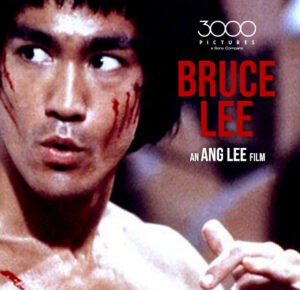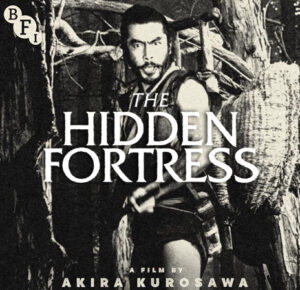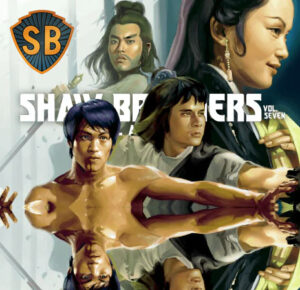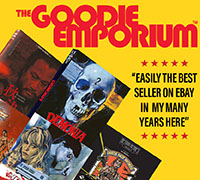
“Time and Tide” Japanese Theatrical Poster
Director: Tsui Hark
Cast: Nicholas Tse, Wu Bai, Candy Lo, Cathy Chui, Joventino Couto Remotigue, Anthony Wong, Jack Kao Jie, Kenji Tanigaki, Frankie Chin Chi Leung
Running Time: 113 min.
By Sergio Martorelli
Hark, the herald angels sing, is back in the Hizzouz!!! After two years in Hollywood helming Jean-Claude Van Damme’s crapfests “Double Team” and “Knock Off”, the main man of action returned to Hong Kong and did “Time and Tide” – that, uneven as it is, packs more excitement in one freeze frame than the entire career of Mr. Muscles From Brussels (BTW, when “Monaco Forever” will be, uh, “outed” on DVD? Everytime I see Van Damme, credited as “The Gay Karate Man”, grabbing another guy’s crotch while grudging lines like “the sky is so beautiful, eh?” and “you have strong legs”, I need a brand new pair of Depends!). I won’t delve into the life and times of Tsui Hark or make comparisons between “Time and Tide” and his past work.
I know he did better movies, but I like to look at the future as well. And judging by this brainless, adrenalin-pumping of a film, the future still looks pretty shiny and bright, thank you very much. Plotwise, “Time” requires complete suspension of disbelief from the get-go. I mean, the villains are chinese actors with chinese features and chinese accents. But they speak spanish and have names like Juan, Pepe and Pablo, so we have to assume they are latin guys! I can live with that, except for one detail: the baddies apparently come from Aracaju, a famous beach in Sergipe, Brazil. So far, so good. But in Hark’s “Aracaju”, everybody speaks spanish (Brazil’s language is portuguese) and there are tornadoes. Damn fucking TORNADOES, crognabbitt! FYI, there are NO twisters, earthquakes or active volcanos to be found anywhere in Brazil, only some floods here and there. So now you know. But why am I bitching about it?
If Hark can get away with chinese latinos, he can put tornadoes in Sergipe if he wants to. At least the end result is a hell of an action scene, far more interesting with strong winds blowing stuff around than any boring, sunny scenario! The story? Oh, yeah. Take notes. Here it goes: there’s this lesbian policewoman called Ah Jo (Cathy Tsui) who’s working as a prostitute decoy. Or maybe she likes to get out at night wearing funny wigs, who knows? After being dumped by her girlfriend, she goes to the nearest bar and challenges the bartender Tyler (Nicholas Tse) for a drinking game, or something like that. Next time we see ’em, they’re puking on taxis and sleeping together. When Ah Jo wakes up with a man, she goes berserk. And with good reason: she got preggers with Tyler’s seed. But Tyler isn’t the fuck’n’run type. He may steal Zippos from time to time, but he’s a nice and responsible guy. Ah Jo wants to keep him away from her life at any cost, but Tyler REALLY cares about her and even gets a job at Uncle Ji’s illegal bodyguard company. Tyler becomes the first bodyguard in movie history to walk around with a TOY GUN, cause Uncle Ji (played by the great Anthony Wong) doesn’t want to give him a real one!
Meanwhile, we’re introduced to Jack (singer Wu Bai), a former member of the brazilian-sino-latin gang. The others call him “Juan”, so I guess Jack is latino too – what may be the reason why the wealthy father of his pregnant wife Ah Hui (Candy Ho) doesn’t like him. Moving on: the gang is planning to move operations from the windy Hark-aracaju to Hong Kong, but that idea doesn’t sit well with Jack, who wants to put his past far, far away, and concentrate on his new life. There we have it: both Tyler and Jack have pregnant ladies to take care of. So where does that lead us? It leads us nowhere, cause Hark’s just throws the story away at this point and starts piling action sequence over action sequence until the last frenetic frame. We already know what we have to about the main characters, we know we like ’em and seeing ’em dying would be not very nice, and now. IT’S CLOBBERIN’ TIME! Action is what we have, in spades and filmed in ways we rarely see since they invented CGI stuntmen. Apart from some Matrix-like effects here and there, what we see is a bunch of REAL stunts, with people jumping from tall buildings that are not green-screen composites.
There are tons of gunplay (see a woman shooting a guy WHILE GIVING BIRTH!), car chases, exploding refrigerators, ass kicking, flying babies and so on till the happy ending! Time and Tide is a movie that will give you a new outlook of life and teach you new and valuable lessons about how to be a better person? Of course not! If you’re a cranky & nerdy Cahiers Du Cinemá-type who likes your movies with deep meanings and hidden messages, you’ll probably say that you just wasted 113 minutes of your life with this dreck. Well… if you don’t like that kind of film, why are you reading this? Go masturbate in Hell, dude! Oh yeah, let’s get technical. Excellent image quality, great surround sound, commentary track by director Tsui Hark is a must-hear (at least his english is understandable), blah blah blah, now leave me alone willya?
Sergio Martorelli’s Rating: 8/10
By Joe909
Everything you’ve read about this movie is true. The plot is impenetrable, you have no idea who anyone is, or what their motivations are, goofy camera tricks straight out of MTV are the order of the day, and the English language is butchered before your very ears, courtesy some dreadlocked punk who likes to talk about cockroaches. But other than that, Time & Tide really isn’t that bad. That’s not to say it’s great, though.
From what I have learned via the Web, it seems that Tsui Hark not only cut down on the length of action scenes when editing his movie, he also cut out dialog scenes. This gives the impression that he took a Wong Kar-Wai approach to editing the movie: filtering out scenes that would actually explain what the hell is going on, leaving it up to the viewer to put the pieces together and follow the plot. However, whereas Wong Kar-Wai is able to do something like this successfully, Hark leaves us with a mess of a story. But then again, stories have never been his strong point. What Time & Tide comes off as is an action movie as produced by an older director who’s trying to prove to the youngsters that he’s hip: it’s got a young, all-star cast, funky music, and special effects straight out of “Fight Club” and “Three Kings.” However, Hark was so busy showing off his experimental skills that he forgot to give us good characters and a discernable story.
The cast is pretty good. Nicholas Tse gets beaten up throughout the movie, but keeps on ticking. I especially liked how he ran around with a fake gun, and had a penchant for pocketing cigarette lighters. Wu Bai was as cool as Mad Dog, from “Hard Boiled.” Bai’s a dead ringer for former Stone Roses lead singer Ian Brown. Wanna see for yourself? Check out the cover to Brown’s first solo album, here. As for the rest of the cast, Anthony Wong stole the show. And the two leading actresses were not only beautiful, but also added a much-needed element of emotion to the film.
The action scenes in this movie are it’s lone saving grace, but they’re still nowhere near as exhilarating as anything in “The Killer,” “Hard-Boiled,” or “A Hero Never Dies.” The action in Time & Tide is more of the cat-and-mouse variety, with Bai’s former comrades hunting him, and vice versa. There are a lot of shots of Bai lurking in corners, or under things, aiming his gun at someone, but very seldom shooting. There isn’t a high body count in Time & Tide, that’s for sure. But that’s probably a good thing; more characters in the movie would only have increased the messiness of the story. There’s even a little wire-fu thrown in, and the shot of Bai rappelling down the building while being shot at is pretty cool. Actually, there’s more rappelling in this movie than “Vertical Limit,” or whatever that “extreme” mountain-climbing movie was named. But anyway, call me old-fashioned, but I’d rather just see a regular, well-choreographed gunfight than slick shots of guys cabling down stairwells or hiding up on the ceiling.
I’d recommend this movie, just because there’s a certain freshness to it, but like I wrote above, you can’t help but get the feeling that Tsui Hark’s trying to come off as cool and “with it” as his younger competitors. Plus, there’s a cool little Bruce Lee reference: when Wu Bai cables down the stairwell, you can hear, coming from someone’s TV, Bruce Lee’s mid-1960s screen test for the role of Kato: “My last name is Lee. Bruce Lee.”
Also, did anyone notice that the main protagonists of this movie ? Tyler and Jack ? have the same names as the two main characters in “Fight Club?”
Joe909’s Rating: 6.5/10
By Woody
This movie blows. And I don’t mean like hot porn stars with big titties who know what they’re doing. This movie blows like a hooker with a bad gag reflex. Yeah, it looks pretty good from the outset, but in the end, it’s a big mess and you want your money back.
Nic Tse (the asshole who is currently banging Faye Wong) is this dude who wants to go to South America, but accidentally gets a cop, who is apparently a lesbian, pregnant. To raise money to give to her for the baby, he hooks up with the woefully underused (at least in this movie…what movie has this guy not been in?!?) Anthony Wong, who runs a bodyguard service. Then a criminal (I say this because I have no idea what the fuck he was supposed to actually be), played by Wu Bai, comes onto the scene and nothing makes sense. I’ve watched this movie more times than God! And still, not one inkling as to what the plot is about. If anyone knows…please, enlighten me!
Oh yeah, the action and special effects are good. But that is kind of like putting cake icing on dog shit. You still wouldn’t eat it…at least I hope not. Then again…some of you guys…tsk..tsk..tsk…
All in all, this is one of those purchases I should have rented before buying. And that is what I recommend you do…I know some who love this, and the smarter of us who don’t. To think, this was supposed to be Tsui Hark’s comeback after all of that Van Dammage he created over here in the States. He should of never fucked with John Woo. What, you think it’s a coincidence Tsui Hark is not famous over here? Remember all that shit Tsui Hark said about John Woo back in the “The Killer” days? You just can’t fuck with my man John Woo. Ya hear that Tsui baby….don’t fuck with the Woo!!!!!!!! Little fucker. Wait…what the fuck was I talking about?!? Oh yeah, Time and Tide. Not recommended.
Woody’s Rating: 4/10
By Numskull
Good Lord. This is the best example of flash over substance I’ve seen since…well, ever.
Time and Tide uses stylish action choreography, hyperactive camera work, bizarre editing effects, and occasional bits of computer animation (such as a sequence showing the inner workings of a handgun as it’s being fired) to gloss over its tepid plot, unremarkable performances, and spectacularly incompetent storytelling. The movie is plagued with poor editing decisions, subplots that don’t go anywhere, and multiple, nameless characters with identical hairstyles. Lots of us like to see creatively shot action and some of us enjoy a storyline that makes you think and forces you to pay attention, but a line has to be drawn somewhere. Time and Tide does such a miserable job of explaining what’s going on, you won’t know who (if anybody) to root for when the bullets start flying. More often than not, the viewer is simply left in the dark.
Nic Tse is a guy who wants to be a beach bum, so he goes from being a bartender to being a bodyguard to earn extra money. Wu Bai is a hitman who sort of befriends Nic and is involved with a group of South American baddies, including a guy with dreadlocks who fries cockroaches with a magnifying glass and has some of the worst (and most unconvincingly delivered) English dialogue the world has ever heard. Anthony Wong plays Nic’s boss and doesn’t have nearly enough to do here. He simply disappears a little over an hour into the movie (which, come to think of it, is probably a good thing…it means he didn’t waste as much time with this film as he could have). There’s also two pregnant women and a slew of supporting characters who exist only to get perforated by gunfire or blown away in other creative ways.
Time and Tide is like Jennifer Lopez: trash, getting by simply by looking good and being a little bold. When the best non-action scene is Nic Tse and a lesbian vomiting on car roofs, you know you’ve got problems. To show you just how much thought went into the script, check this out: Dreadlock Man says that a certain job is arranged for “the third Friday of this month,” which happens to fall on the 13th. Now, unless the calendar week has been shortened by at least one full day without my knowledge, this situation is IMPOSSIBLE…the third one of any day in any month cannot be earlier than the 15th of that month. Did they let this slip by because they thought no one would notice, or were they just too fucking stupid to catch it in the first place?
Fun is fun, and action movies need not have riveting premises to be enjoyable. I’ve given high praise in the past to films with little going for them EXCEPT the action…the difference between them and this, my friends, is that THEIR plots, while not exactly possessed of breathtaking creativity, were at least comprehensible. THIS, on the other hand…this just blows. It’s an overhyped, overrated, overstylized mess. I’ll give it credit for well-staged fights and shootouts, but as far as everything else goes, the cast and primary creative forces should hang their heads in shame. If anyone tries to tell you that they “got it”…ALL of it…on their first time, and that your confusion regarding certain plot elements is due to your failure to pay sufficient attention, you can rest assured that that person is full of shit.
Numskull’s Rating: 4/10
By Alexander
It absolutely boggles my Asian cinema saturated mind that films like “The Musketeer”, “Kiss of the Dragon”, “Rush Hour 2”, “Replacement Killers” and other HK/U.S. hybrids get wide domestic releases and open big but a film like Tsui Hark’s “Time and Tide”, one of the greatest action films ever made, disappears from two, TWO, L.A. area movie houses in a single weekend. American audiences are supposedly major fans of the action genre (evidenced by the late-’80s to early-’90s successes of muscle laden hulks like Schwarzennegar, Van Damme, Lundgren, Stallone, etc.?), yet “Time and Tide” — bursting at the blood-soaked seams with some of the most creatively filmed action EVER and surpasses even Woo’s endeavors in “The Killer” and “Hard Boiled” — dies a painfully quick and ignored death on a few screens nationwide and is relegated to a few rental copies at Blockbuster and the discount shelves at Best Buy. If any recent Asian film could have, SHOULD have capitalized on the “Crouching Tiger, Hidden Dragon” craze, subtitles and all, “Time and Tide” was it. Sadly, Tsui Hark’s “Tide” will be widely ignored by mainstream audiences and only embraced by those of us that bother to read the updates on COF. A shame!
About “Time and Tide”:
Wu Bai is amazing. His agility is simply astounding and easily rivals the athleticism of both Jackie Chan and Jet Li. It was also entirely refreshing to see a HK film starring someone who wasn’t cast simply because of their model good looks and magazine cover resume. And Nicholas Tse proves he’s not just a HK pretty boy. His perfomance is one of the best I’ve seen. Finally, Candy Lo, Cathy Chui and Joventino Remotigue add style and flair to round out the cast.
I’m not a huge fan of Tsui Hark’s (I still think “OUATIC” is overrated), but “Tide” includes some of the most creatively filmed scenes in cinematic history. His camera literally goes everywhere. And Xiong Xin-Xin’s action sequences surpass anything in “Hard Boiled” and “The Killer”, my two favorite HK films.
The ONLY negative thing I can say about this film is that its plot is so convoluted you’ll be scratching your head just minutes into it wondering what the hell is going on. Characters seemingly appear out of nowhere and their allegiances are never adequately explained. (For instance, Wu Bai plays a shady character with ties to a drug cartel but he quickly becomes allies with good-guy Nicholas Tse. Hm.) Regardless, “Time and Tide” is easily the most enjoyable HK film I’ve seen since Woo’s masterpieces “The Killer”, “Hard Boiled”, and “ABITH”. HIGHLY recommended.
Alexander’s Rating: 9.5/10
By Vic Nguyen
SETTING: East Dallas Apartment, pitch black wonderland
Insomnia, insomnia, insomnia. As I am typing this sentence, it is 2:30 in the morning, June 8th, central standard time. The Colorado Avalanche have just won the Stanley Cup (thereby, defecating on Dallas Stars fans everywhere), the city of Houston, Texas has officially become nature’s toilet bowl, and Superman 3 is playing on local television (you know, the one where Sup’s battles that golden lightning bolt homosexual with an eery resemblance to John Tesh with a mullet). I have forcefully planted myself in front of an outdated lab top, opened to Microsoft Word, hoping to type up something meaningful before eventually succumbing to the heavenly bliss of slumber. In the middle of an 8 page essay discussing the merits of Swordfish (both the seafood and the John Travolta vehicle), I am suddenly blindsided by a voice of inspiration, telling me to type up a review of Tsui Hark’s Time and Tide for cityonfire.com. “Why Time and Tide, and why cityonfire.com?” I questioned, but the voice (a forceful individual who identified himself as the Mighty Peking Man), answered with a resounding “shut the fuck up and do as I say.” Having never refused mighty peking men before, I immediately closed my essay on Swordfish (without saving, mind you), and proceeded to work on a review that will hopefully do justice for another masterpiece by the brilliant Tsui Ha…
Dozes off… (Setting: same fucking place, about 12 in the afternoon, June 9th)
(Disclaimer: the above paragraph was written in a haze of bewilderment, alcohol, and as mentioned previously, insomnia. There was no forceful mighty peking man, and I didn’t write an essay on Swordfish (which was a piece of shit by the way, despite Halle Berry’s tits). However, the Colorado Avs did win the cup, Houston really did become nature’s toilet bowl, and Superman 3 really was playing on TV (which goes to show that I had a semblance of sanity at that particular period of time). People do weird shit when they are denied sleep, and what you just read up above should be valid enough proof. So apologies for forcing you to read that meandering shit, and without further ado, here is the review for Time and Tide that you were hoping to read.)
THE ACTUAL REVIEW FOR TSUI HARK’S TIME AND TIDE:
Tsui Hark is a fucking genius. His resume is literally a collection of the best films that Hong Kong cinema has to offer (with diverse features ranging from unpretentious fun (Working Class) to genre-blending masterpiece (Peking Opera Blues), to kung fu epic (Once Upon a Time in China series) to enjoyable oddity (Tri-star), and his Hollywood offerings have been over-criticized (in fact, I feel that Knock Off is vastly underrated, but maybe that’s just me).
With Time and Tide, Tsui Hark, unsurprisingly, reinvents himself once more, giving the audience a fun little adrenaline rush that manages to outdo Knock Off in terms of cinematographic lunacy. I’m hard pressed to come up with a coherent plotline, so let’s just say that it involves a bodyguard corporation (headed by Anthony Wong), a bunch of pregnant women, Latin American’s, a one-night stand, invincible refrigerators, and Canto-pop.
Plot is of little concern anyway, as Time and Tide has so much else going for it. The performances are generally very good (with the exception of the Spanish-speaking performers, who, like the majority of foreigners in a Hong Kong film, are incompetent). Taiwanese musician Wu Bai, in particular, is quite engaging in the second lead role, and performs with considerable skill both acting and action wise. Nicholas Tse is as good as usual (he has grown on me ever since I saw him in Gen-X Cops and Metade Fumaca), while Anthony Wong comes off admirably in a limited supporting role.
The action sequences are choreographed with plenty of flash and athleticism by the great Xiong Xinxin, and are plentiful throughout the duration of the film (the final 45 or so minutes is peppered with nothing but action setpieces). The special effects are quite good for the limited budget allotted for the film, and the cinematography, as mentioned before, is something that must be seen to believe (the camera will literally go anywhere at any time). Not the most intelligent film in the world, but does that really matter?
Time and Tide has received a limited release through cinemas across the country, and is a film that MUST be appreciated on the big screen. Hopefully, it will make it’s way into Dallas soon. Until then, I’m content with my VCD, which boasts great picture (for a VCD) and sharp subtitles (despite the fact that it is full screen).
Vic Nguyen’s Rating: 9.5/10






















Be the 1st to Comment